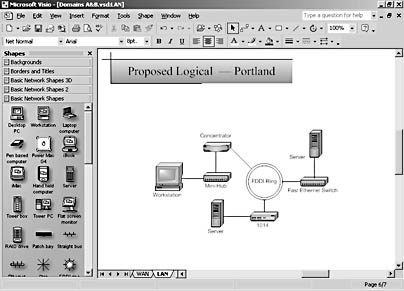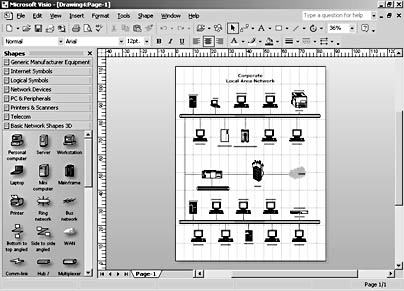Starting a Network Diagram
3 4
The tools in Visio Standard and Visio Professional work best for creating high-level logical designs for presentations and proposals. These high-level network diagrams need to be accurate, but you typically don't need to show specific network equipment in detail, as Figure 14-1 shows. Both Standard and Professional include shapes for diagramming a small-sized or medium-sized network; Visio Professional simply includes more shapes.

Figure 14-1. A high-level logical network diagram provides a useful visual for reports, proposals, and presentations.
The bit about diagramming a "small-sized to medium-sized network" is important. What you're doing is dragging Visio shapes that look like network equipment onto the drawing page, one by one. One network specialist in a Visio focus group complained that Visio wasn't much better than using pen and paper. That's an extreme view, but it represents a valid point for the people in charge of large networks. You'll probably want a more automated tool if you want to show every hub, router, and workstation on your network. That tool used to be Visio 2000 Enterprise Edition, which included the AutoDiscovery And Layout tool. Although that product is no longer supported, its automated tools are still available as add-ins.
For details about AutoDiscovery and Visio Network Equipment, see the sidebar "What Happened to AutoDiscovery and VNE?"
What if you need more detailed documentation for troubleshooting or asset management? Your network diagrams can include this type of information, such as a device's model, tracking number, and network address. Network shapes include built-in custom properties, which you can use as data entry fields to store detailed attributes with each shape. In turn, the data you enter helps you troubleshoot problem areas, generate cost estimates and other reports, and perform quick inventories.
Choosing a Network Template
To start a new network diagram of any type, it's best to start with a template, which opens up the stencils containing the shapes you'll need and sets up the drawing page for you. Depending on the Visio product version you have, you might not have much of a choice when it comes to choosing a network template. Visio Standard includes only one (Basic Network). Visio Professional includes several more, as well as all the shapes that are in Visio Standard.
Visio Standard Network Tools
If you have Visio Standard, you have the Basic Network template, which is useful for diagramming a simple network. Figure 14-2 shows a simple network diagram in Visio

Figure 14-2. Both Visio Standard and Visio Professional include the Basic Network template, which was used to diagram this e-commerce server.
Professional. When you start a network diagram with this template, Visio opens an unscaled, letter-sized drawing page and the following stencils:
- Basic Network Shapes. This stencil includes topology shapes, workstations, PCs, printers, scanners, and shapes for other common devices.
- Basic Network Shapes 2. This stencil contains mainframes, network controllers, and a variety of communication shapes (satellite dishes, radio towers, and so forth).
- Basic Network Shapes 3D. This stencil includes the most common equipment types in 3-D form to make presentations and proposals look especially nice.
- Borders And Titles. This stencil contains a set of ornamental page borders and title shapes for identifying your diagram.
- Backgrounds. This stencil contains decorative images for formatting the background of your diagram. The Background World and Background Expedition shapes are useful images for wide-area networks.
Visio Professional Network Tools
If you have Visio Professional, in addition to the Basic Network template, you also have the Logical Network Diagram template, shown in Figure 14-3. Use this template to diagram the following:
- Logical networks that represent the equipment in a network and their interconnections.
- Physical networks that show physical connections between network equipment, or site-specific layouts, such as a server room.
When you start a new diagram with this template, Visio opens a scaled drawing page where 1 inch on the page equals 10 inches in the real world. The drawing page displays an uneven grid—the horizontal lines are more closely spaced to make it easier to align shapes. The template also opens the following stencils:
- Generic Manufacturer Equipment. This stencil contains hubs, chassis, and switches that represent common equipment from 3Com, Bay Networks, Cabletron, Cisco, Compaq, Data General, DEC, Hewlett-Packard, IBM, and Nortel.
- Internet Symbols. This stencil includes a few common visual metaphors for firewalls and other Internet items.
- Logical Symbols. This stencil provides visual metaphors for a host of network-related items, including buildings, routers and switches, and communications servers.
- Network Devices. This stencil contains bridges, routers, servers, and other generic devices.
- PC And Peripherals. This stencil contains a wider variety of devices, such as a CE/notebook–type shape, DVD player, and CD burner.
- Printers And Scanners. This stencil contains generic equipment shapes for a variety of printer and scanner types.
- Telecom. This stencil contains shapes for devices like cable modems and pagers.

Figure 14-3. With Visio Professional, you can use the Logical Network Diagram template to assemble a network diagram quickly.
Visio Professional also includes the Visio Network Equipment Sampler template, which opens the Visio Network Equipment Sampler stencil. If you need exact-replica equipment shapes for a network diagram, it's easiest to start a diagram with the Logical Network Diagram template, and then open the Visio Network Equipment Sampler stencil. (Choose File, Stencils, Network, Visio Network Equipment Sampler.) The exact-replica equipment shapes are groups that contain a metafile, which makes them difficult to edit. For details, see "Customizing Network Shapes."
Note
Visio Professional includes network templates for creating a directory diagram of Microsoft Active Directory, Novell Directory Services, and other directory structures. For details about using these templates, see "Creating a Directory Diagram."
What Happened to AutoDiscovery and VNE?
The AutoDiscovery And Layout tool formerly provided with Visio 2000 Enterprise Edition is an advanced IP discovery engine that uses Simple Network Management Protocol (SNMP) to discover routers, switches, hubs, workstations, printers, and more. It also supports the discovery of layer 2, layer 3, frame relay, Cisco virtual local area network (VLAN) and Spanning Tree, and Windows Management Instrumentation (WMI) configuration information. The Visio Network Equipment (VNE) shapes include a library of more than 22,000 exact-replica network equipment shapes from hundreds of leading manufacturers. New shapes are regularly added to a database and are available by subscription.
Do these tools sound like something you need? They are now available in the Microsoft Visio Enterprise Network Tools add-in. For details about all the tools and services that are provided with this add-in, choose Help, Visio Network Solutions.
Setting Up a New Network Diagram
To set up a new network diagram, follow these steps:
- Choose File, New, Network, and then choose the name of the template you want. Visio opens a letter-sized, blank drawing page and the appropriate stencils.
- If you want to change the size or orientation of the page, choose File, Page Setup, click the Page Size tab, and then specify the page settings you want.
- If you plan to print your network diagram, click the Print Setup tab, and make sure that the page size that you set on the Page Size tab will work with your printer.
For details about how page size and printer settings interact, see "Printing Diagrams of Any Size."
- If you started your diagram with the Logical Network Diagram template, click the Drawing Scale tab, and then change the Custom Scale setting if you want.
- Click OK to close the Page Setup dialog box.
- If you want to customize the grid that's displayed on the drawing page, choose Tools, Ruler & Grid. In the Grid area, specify the settings you want, and then click OK.
For details about grid settings, see "Controlling Grid Spacing and Origin."
Now that you have verified that the template created the size and style of page you want, you can start adding shapes to your diagram. Start with the physical topology shapes if you're creating a logical diagram. For a WAN, start with the background image you want to use, such as a map, an imported graphic or clip art, or a shape from the Backgrounds stencil.
After you have connected all the network equipment that you want to represent in your diagram, you have several options, which are covered later in this chapter:
- Assign shapes to layers to view or print categories of shapes.
- Edit the network shapes.
- Import or add data to shapes, and then generate reports.
- Link shapes to other drawing pages, other files, or World Wide Web locations.
EAN: 2147483647
Pages: 211